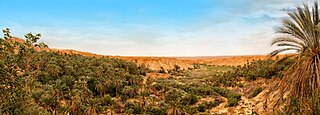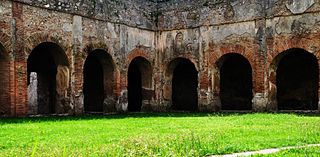
Leptis or Leptis Magna, also known by other names in antiquity, was a prominent city of the Carthaginian Empire and Roman Libya at the mouth of the Wadi Lebdam in the Mediterranean.

Oea was an ancient city in present-day Centreville à le Souq Yafran in Tripoli, Libya. It was founded by the Phoenicians in the 7th century BC and later became a Roman–Berber colony. As part of the Roman Africa Nova province, Oea and surrounding Tripolitania were prosperous. It reached its height in the 2nd and 3rd centuries AD, when the city experienced a golden age under the Severan dynasty in nearby Leptis Magna. The city was conquered by the Rashidun Caliphate with the spread of Islam in the 7th century and came to be known as Tripoli during the 9th century.
A latifundium is a very extensive parcel of privately owned land. The latifundia of Roman history were great landed estates specializing in agriculture destined for export: grain, olive oil, or wine. They were characteristic of Magna Graecia and Sicily, Egypt, Northwest Africa and Hispania Baetica. The latifundia were the closest approximation to industrialized agriculture in Antiquity, and their economics depended upon slavery.

Tripolitania is a historic region and former province of Libya.

Sabratha, Sabratah or Siburata, in the Zawiya District of Libya, was the westernmost of the ancient "three cities" of Roman Tripolis. From 2001 to 2007 it was the capital of the former Sabratha wa Sorman District. It lies on the Mediterranean coast about 70 km (43 mi) west of modern Tripoli. The extant archaeological site was inscribed as a UNESCO World Heritage Site in 1982.

El Djem or El Jem is a town in Mahdia Governorate, Tunisia. Its population was 21,576 during the 2014 census. It is home to some of the most impressive Roman remains in Africa, particularly the world-famous "Amphitheater of El Jem".

Barca, also called Barce, was an ancient city and former bishopric, which survives as both a Latin Catholic and an Orthodox titular see.

Policastro Bussentino is an Italian town and hamlet (frazione) of the municipality of Santa Marina in the province of Salerno, Campania region. It is a former bishopric, now titular see, and has a population of 1,625.

Villa Magna is a large ancient imperial Roman villa near the modern town of Anagni, in Lazio, central Italy. The site lies in the Valle del Sacco some 65 km south of Rome, at the foot of the Monti Lepini, directly under the peak known as Monte Giuliano. The toponym 'Villamagna' remains attached to the site, attesting to the local memory of the imperial villa and its successive occupation as a monastery and lay community.
Aïn El Kebira is a city located 27 km north far from Sétif. As Ancient Satafis it was a bishopric, which remains a Catholic titular see.

Negrine is a town and commune in Tébessa Province in north-eastern Algeria. It was the site of ancient Casae Nigrae, a settlement of Roman North Africa with an attached bishopric that remains a Latin Catholic titular see.

The area of North Africa which has been known as Libya since 1911 was under Roman domination between 146 BC and 672 AD. The Latin name Libya at the time referred to the continent of Africa in general. What is now coastal Libya was known as Tripolitania and Pentapolis, divided between the Africa province in the west, and Creta et Cyrenaica in the east. In 296 AD, the Emperor Diocletian separated the administration of Crete from Cyrenaica and in the latter formed the new provinces of "Upper Libya" and "Lower Libya", using the term Libya as a political state for the first time in history.

The Villa Romana or Roman Villa is an archaeological ruin from the 1st century in the Italian village of Minori, in Campania.

Bir el Ater is a city located in far eastern Algeria. It is located towards the border with Tunisia, around 87 kilometers south of Tebessa and just beyond the Sahara. The town has a population of approximately 120,000 inhabitants.

Villamagna of Tripolitania was a Roman era settlement in what was the Roman province of Tripolitania. The town is identifiable with ruins at Henchir-Sidi-Abdein in today's Libya.
This page is based on this
Wikipedia article Text is available under the
CC BY-SA 4.0 license; additional terms may apply.
Images, videos and audio are available under their respective licenses.











